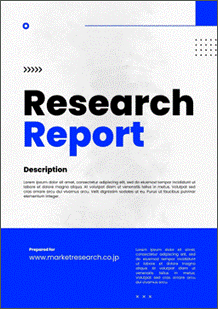 | • レポートコード:MRC2304G229 • 出版社/出版日:Mordor Intelligence / 2023年2月 • レポート形態:英文、PDF、90ページ • 納品方法:Eメール(受注後2-3営業日) • 産業分類:化学 |
| Single User | ¥703,000 (USD4,750) | ▷ お問い合わせ |
| Corporate License | ¥1,295,000 (USD8,750) | ▷ お問い合わせ |
• お支払方法:銀行振込(納品後、ご請求書送付)
レポート概要
| Mordor Intelligence社の本調査資料では、世界のアスコルビン酸市場規模が、予測期間中(2022年〜2027年)にCAGR5.1%で拡大すると展望しています。本資料は、アスコルビン酸の世界市場について調査を行い、市場の現状や動向をまとめています。イントロダクション、調査手法、エグゼクティブサマリー、市場動向、用途別(食品・飲料、医薬品・ヘルスケア、美容・パーソナルケア、動物飼料)分析、地域別(アメリカ、カナダ、メキシコ、スペイン、イギリス、ドイツ、フランス、イタリア、ロシア、中国、日本、インド、オーストラリア、ブラジル、アルゼンチン、南アフリカ、UAE)分析、競争状況、市場機会・将来の動向、新型コロナウイルス感染症の影響など、以下の項目を掲載しています。また、主要参入企業として、BASF SE、Merck KGaA、Koninklijke DSM NV、Northeast Pharmaceutical Group Co. Ltd、Luwei Pharmaceutical Group Co. Ltd、Foodchem International Corporation、Honson Pharmatech Group、MC Biotec Inc.、Freshine Chem、CSPC Pharmaceutical Groupなどの情報を含んでいます。 ・イントロダクション ・調査手法 ・エグゼクティブサマリー ・市場動向 ・世界のアスコルビン酸市場規模:用途別 - 食品・飲料における市場規模 - 医薬品・ヘルスケアにおける市場規模 - 美容・パーソナルケアにおける市場規模 - 動物飼料における市場規模 ・世界のアスコルビン酸市場規模:地域別 - 北米のアスコルビン酸市場規模 アメリカのアスコルビン酸市場規模 カナダのアスコルビン酸市場規模 メキシコのアスコルビン酸市場規模 … - ヨーロッパのアスコルビン酸市場規模 イギリスのアスコルビン酸市場規模 フランスのアスコルビン酸市場規模 イタリアのアスコルビン酸市場規模 … - アジア太平洋のアスコルビン酸市場規模 中国のアスコルビン酸市場規模 インドのアスコルビン酸市場規模 日本のアスコルビン酸市場規模 … - 南米/中東のアスコルビン酸市場規模 ブラジルのアスコルビン酸市場規模 アルゼンチンのアスコルビン酸市場規模 南アフリカのアスコルビン酸市場規模 … - その他地域のアスコルビン酸市場規模 ・競争状況 ・市場機会・将来の動向 ・新型コロナウイルス感染症の影響 |
The ascorbic acid market is projected to register a CAGR of 5.1% during the forecast period (2022-2027).
Ascorbic acid is a water-soluble vitamin that is effective for patients with critical illnesses. The COVID-19 pandemic positively impacted the market’s growth due to the growing need for vitamin C to build immunity in individuals. Ascorbic acid was also used to cure the patients with mild symptoms of COVID-19. Individuals were also inclined toward taking vitamin C supplements to stay fit and boost their immunity to protect themselves from getting affected by the virus.
The market has been witnessing growth in China due to the maximum production of vitamin C in the country. The country holds high power in setting the global prices of the ingredient, which is a major factor driving the market. The increasing usage of vitamin C in cosmetics and personal care products has added to the growth of the ascorbic acid market.
The paradigm shift from clean-label food and beverage products to dietary supplements has led to the emergence of many manufacturers offering clean-labeled vitamin C supplements to consumers seeking antioxidant support for immune health through supplements. As a result, the demand for ascorbic acid has increased in the pharmaceutical and healthcare industry.
Ascorbic Acid Market Trends
Increasing Demand from Fortified/Functional Food and Beverage Application
With the rising number of health-conscious individuals, the demand for fortified food and beverage is also increasing. Consumers, primarily in developed and developing countries like the United States, India, China, and Germany, are increasingly reaching for nutrient-based and other products containing functional ingredients to ward off illnesses or help with existing health issues. The demand for fortified food and beverage has led the companies to incorporate ascorbic acid into their products. For instance, in 2021, Krating Daeng, a brand of TCH Group, collaborated with DHC, the leading food supplement producer in Japan, catering to the vitamin C demand in Thailand. Also, various government initiatives are being taken to increase the consumption of fortified food and beverages, especially in developing countries like China and India. For instance, China’s Ministry of Health promotes the intake of fortified food due to growing health concerns relating to age, myopia, and other diseases, thus driving the demand for ascorbic acid in the region.
Asia-Pacific Emerges as the Largest Market
The consumption of ascorbic acid in Asian countries, primarily in India, China, and Japan, is expected to grow rapidly due to the cost-effective manufacturing facilities in these countries. This factor has paved the way for manufacturers to penetrate the functional food and beverage sector with innovative bioactive ingredients, including ascorbic acid. The growing demand for health and dietary supplements in the region is also expected to fuel the market’s growth over the forecast period. Deficiencies of significant micronutrients like iodine, vitamins A and C, iron, folate, and zinc are prevalent in Asian countries, making the region a lucrative market for vitamin C manufacturers and suppliers worldwide. The region is witnessing growth in personal disposable income and supportive government policies, adding to the growing demand. The growth of the pharmaceutical industry is prominent in the regional market, which drives the demand for ascorbic acid. For instance, according to the India Brand Equity Foundation, the Indian pharmaceutical market grew from 13.7% in July 2020 to 17.7% in August 2021.
Ascorbic Acid Market Competitor Analysis
The ascorbic acid market is highly fragmented, with an increasing number of local and regional players worldwide. Key players like Merck KGaA, Koninklijke DSM NV, Luwei Pharmaceutical Group Co. Ltd, and Northeast Pharmaceutical Group Co. Ltd cater to a majority of the market. The companies are utilizing their products and technological skills to develop marketing and business strategies across the vitamin and mineral supplements segment, driving innovations, stimulating new product developments, and business planning and branding across social media platforms.
Additional Benefits:
- The market estimate (ME) sheet in Excel format
- 3 months of analyst support
1 INTRODUCTION
1.1 Study Assumptions and Market Definition
1.2 Scope of the Study
2 RESEARCH METHODOLOGY
3 EXECUTIVE SUMMARY
4 MARKET DYNAMICS
4.1 Market Drivers
4.2 Market Restraints
4.3 Porter’s Five Forces Analysis
4.3.1 Threat of New Entrants
4.3.2 Bargaining Power of Buyers/Consumers
4.3.3 Bargaining Power of Suppliers
4.3.4 Threat of Substitute Products
4.3.5 Intensity of Competitive Rivalry
5 MARKET SEGMENTATION
5.1 By Application
5.1.1 Food and Beverage
5.1.2 Pharmaceuticals and Healthcare
5.1.3 Beauty and Personal Care
5.1.4 Animal Feed
5.2 By Geography
5.2.1 North America
5.2.1.1 United States
5.2.1.2 Canada
5.2.1.3 Mexico
5.2.1.4 Rest of North America
5.2.2 Europe
5.2.2.1 Spain
5.2.2.2 United Kingdom
5.2.2.3 Germany
5.2.2.4 France
5.2.2.5 Italy
5.2.2.6 Russia
5.2.2.7 Rest of Europe
5.2.3 Asia-Pacific
5.2.3.1 China
5.2.3.2 Japan
5.2.3.3 India
5.2.3.4 Australia
5.2.3.5 Rest of Asia-Pacific
5.2.4 South America
5.2.4.1 Brazil
5.2.4.2 Argentina
5.2.4.3 Rest of South America
5.2.5 Middle-East
5.2.5.1 South Africa
5.2.5.2 United Arab Emirates
5.2.5.3 Rest of Middle-East
6 COMPETITIVE LANDSCAPE
6.1 Most Active Companies
6.2 Most Adopted Strategies
6.3 Market Share Analysis
6.4 Company Profiles
6.4.1 BASF SE
6.4.2 Merck KGaA
6.4.3 Koninklijke DSM NV
6.4.4 Northeast Pharmaceutical Group Co. Ltd
6.4.5 Luwei Pharmaceutical Group Co. Ltd
6.4.6 Foodchem International Corporation
6.4.7 Honson Pharmatech Group
6.4.8 MC Biotec Inc.
6.4.9 Freshine Chem
6.4.10 CSPC Pharmaceutical Group
7 MARKET OPPORTUNITIES AND FUTURE TRENDS
8 IMPACT OF COVID-19 ON THE MARKET